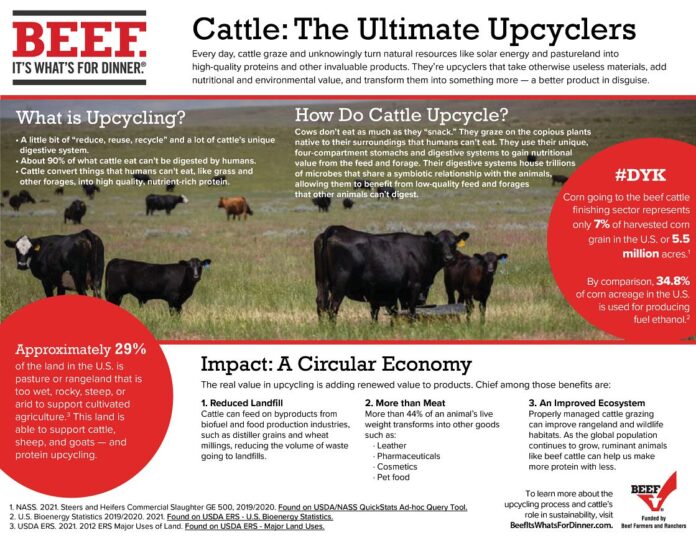WHY ARE LIVESTOCK CALLED NATURAL UPCYCLERS
What is “upcycling”?
When cattle graze, their ruminant digestive system turns things humans can’t eat, like grass, other forages, and byproducts – such as distillers grain, cottonseed, and beet pulp – into high quality protein and micronutrients for human consumption – a process called upcycling.
The term “upcycling” refers to converting a little-to-no-value item to a higher-value product. As ruminants, cattle act as natural upcyclers — they consume low-value, humaninedible plants and regenerate them into a high-quality protein that provides nutrition for people across the globe. The forage-based diet of cattle sets them apart from pigs, chickens and other nonruminants because other animals cannot convert forage to protein as cattle can. As the structural component of plants, cellulose is the most abundant carbohydrate on Earth. However, humans cannot digest cellulose, deeming it of no nutritional value when eaten. Due to the unique enzymes in their rumens, cattle can break down cellulose and convert it from low-value forage into a highquality protein source to supply humans with dietary essential amino acids that serve as the building blocks of protein. Upcycling in the cattle industry also occurs through cattle’s consumption of inedible byproducts or plant leftovers from processing crops. Byproducts, such as soy hulls, carrot tops, wheat middlings and citrus pulp, are viable sources of nutrition for ruminants.
Cattle ranching is the perfect example of “upcycling.” Cattle graze on grasslands turning natural resources like pastureland and solar energy into beef and other everyday products. They are upcyclers that take otherwise useless materials, add nutritional and environmental value, and transform them into a high-quality protein and essential micronutrients.
HOW DO CATTLE UPCYCLE?
About 90% of what cattle eat can’t be digested by humans, making them invaluable to a sustainable food system. Cattle consume plants that humans can’t eat and through their unique digestive system, transform these plants into a high-quality, nutrient-rich protein. In addition to the grasses they graze on for most of their lives, cattle can eat numerous other food byproducts. They can take items like brewers’ grains, pea pulp, beet tops, and potato peelings and turn those products into beef.
By using byproducts that would otherwise go to waste, cattle are enhancing the sustainability of other industries. For example, cattle eat distillers grains from the corn ethanol industry, cottonseed that is a byproduct of cotton production, and beet pulp that is a byproduct of sugar beet production.
cattle graze on plants native to their surroundings that humans can’t eat. Their unique, four-compartment stomach and digestive system is home to trillions of microbes. These microbes allow cattle to benefit and gain nutritional value from these sources that other animals can’t digest.
THE VALUE OF UPCYCLING
- Upcycling adds additional value to products that otherwise would’ve been wasted.
- Byproducts from biofuel and food production industries, such as distillers grains and beet pulp, are digestible by cattle, reducing the volume of waste going to landfills.
- Properly managed cattle grazing can improve rangeland and wildlife habitats.
- As the global population continues to grow, ruminant animals like beef cattle can help us make more food with less.
- More than 44% of an animal’s live weight transforms into other goods such as leather, cosmetics and pet food.
Compiled & Shared by- Team, LITD (Livestock Institute of Training & Development)
Image-Courtesy-Google
Reference-On Request.


